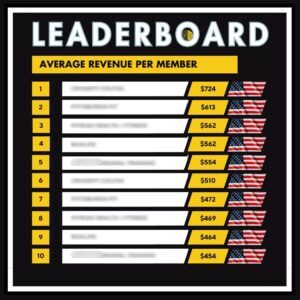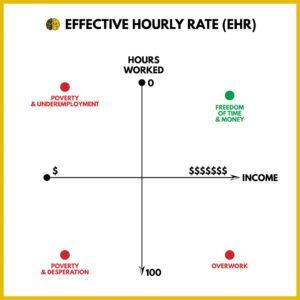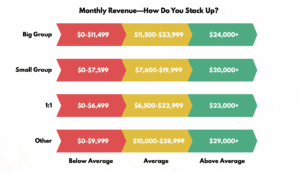Chris Cooper's Blog, page 3
September 17, 2025
Fix Your Marketing Funnels: How to Get and Keep More Clients
Many gym owners try to solve every problem with “more clients.”
But pushing more clients in a broken gym or leaky funnel is like running a knocking engine hard: Everything just breaks faster.
The truth: the average coaching gym worldwide has 122.5 clients. Not 300 or 500.
So start with this assumption: You’ll have 120–150 great members who pay the right rate and stay for two years or more. If you check all these boxes, you will have a rock-solid business that can pay you $100,000 a year or more.
So how do you actually get the right number of people at the right rates?
You don’t chase gimmicks or guess at marketing. You audit and fix your funnels. At Two-Brain, we use four of them:
ReferralsContentSocial mediaPaid ads
1. Referral Funnel
Too many gym owners are passive about referrals. They hope clients will bring in friends. Hope is not a strategy.
Referrals only work if you ask. Clients love you, but they’re not marketers. They won’t book appointments for their friends unless you help them.
Action Step: The next time a client mentions an acquaintance who might need help, take the lead and ask how you can get that person in the gym.
2. Content Funnel
Are you producing helpful things for your audience to make connections, build rapport and establish expertise?
You cannot wait for people to just come into your gym. You must give them useful information. You must give them free knowledge and sell a coaching program at the end of the fitness or nutrition tip.
Remember, sales is the first act of coaching. And, honestly, everybody needs coaching.
Action Step: Set up a basic content calendar to develop a publishing habit and hold yourself accountable.
3. Social Media Funnel
A lot of people post to social media sporadically, and the funnel doesn’t lead anywhere.
Your social media funnel should shuttle people off platforms and into your waiting arms. It must get them from Instagram, TikTok, Facebook and LinkedIn and onto your website. And then your website must get them into your chair—butts in seats—so you can coach them to join your gym.
Is your funnel doing that? Or are you just posting random stuff?
Are you posting at all? Are you posting 10 times a week with calls to action in at least every third post? If you’re not, you have a platform, but it’s not growing your business.
Action Step: Add a call to action on every third post. Example: “Book a No Sweat Intro today.”
4. Paid Ads Funnel
Paid ads aren’t magic—but they don’t have to be scary, either.
Platforms—Facebook, TikTok, Instagram, etc.—are putting all your potential clients in one spot and then saying, “If you give us money, we’ll let you talk to them.”
That sounds like a good deal to me.
The truth: You don’t need huge budgets; you need skill with ads. A mentor can help.
Action Step: Don’t guess. Start small with ads and track the results carefully. Double down on winners and divert resources away from underperformers.

Audit Your Funnel Metrics
These four funnels only work if you track your numbers.
Measure three things:
1. Set Rate—the number of website visitors who book an appointment.
A: 62% or betterC: 30-61%F: <30% or “I don’t know”
2. Show Rate—the number of bookers who actually show up for appointments.
3. Close Rate –the number of people who show up and sign up.

Fix the Weakest Link
Once you know your numbers, you can solve the real problem instead of guessing.
I’ll give you three tactics for each metric.
If set rate is low:
Improve speed to contact.Improve your website’s call to action.Increase your outreach volume.
If show rate is low:
If close rate is low:
Your Quick Daily Challenge
Marketing can’t be passive. You must build, test and improve systems.
Here’s your simple challenge to start. The four activities below are enough to get you to a C grade and start building momentum. Block off an hour every day and work on this:
Ask for five referrals a month.Publish five big content pieces every month.Post five times a week on social.Spend $5 a day on ads.
Later, hit 10-10-10-10, and then 15-15-15-15.
Build and improve your funnels—that’s how you move from an F to a C to an A in marketing.
Do this stuff daily, and you’ll build a marketing machine that brings in the high-value clients who will sustain an amazing business that pays you well.
We teach gym owners exactly how to build these four funnels step by step. To find out how to supercharge your marketing, book a call here.
The post Fix Your Marketing Funnels: How to Get and Keep More Clients appeared first on Two-Brain Business.
September 16, 2025
The Essential Fall Gym Audit: 6 Metrics That Actually Matter
Let’s get right down to business now that fall is here.
I want you to end 2025 with improved metrics and massive momentum for 2026.
Here’s exactly how we’ll do it:
I’ll lay out the six metrics that really move the needle for gym owners.I’ll reference our 2024 “State of the Industry” report—the largest data set in the fitness world—and tell you exactly what numbers earn you a C grade.I’ll give you tactics you can use today to beat those numbers and get an A.
Remember, if you don’t have any numbers at all, you can’t evaluate your business. You must have data if you want to succeed as a fitness entrepreneur—and Two-Brain can help you learn to track and improve these critical numbers.
1. Average Revenue per Member (ARM)
ARM is the clearest measure of the value your clients place on your service. Across 15,000 gyms who contributed to our 2024 report, here’s the benchmark for a C grade:
Large-group gyms: US$167.76 per member per month.Small-group gyms: $230.18.One-on-one studios: $353.37.
If your ARM needs improvement, here’s how to raise it:
 Top Two-Brain gyms post incredible ARM numbers.
Top Two-Brain gyms post incredible ARM numbers.1. Add an On-Ramp—Don’t throw new people into classes cold. A structured onboarding process raises ARM and boosts retention.
2. Run Specialty Programs—Test quarterly offerings such as a legends program (for clients 60+), nutrition challenges or sport-specific training.
3. Increase Rates—This can be hard but is often necessary. Most gyms can handle a 15 percent increase without excessive churn, and that revenue goes straight to the bottom line. (A mentor can help you calculate the increase you need and walk you through the exact rollout steps so you retain your clients.)
A+: Two-Brain’s top gyms have ARM scores from $450 to $700-plus.
2. Length of Engagement (LEG)
If clients don’t stay at least two years, you’re not changing lives.
Here’s how to improve LEG:
1. Add on On-Ramp (Yes, I’m saying this again)—Use a free consultation, not a free trial, to sell and then feed new members into a high-touch integration program with a ton of support. An on-ramp is a barrier to exit, not entry.
2. Map the First 90 Days of the Client Journey—Plan every step: welcomes, texts, skill teaching, goal reviews, etc. Affirm their purchase, acclimate them and celebrate them.
3. Quarterly Goal Reviews—Measure what they care about, not what you care about. Use these sessions to prescribe the next step—and ask for referrals.
A+: 25 months or more.

3. Return on Investment (ROI)
Every dollar that doesn’t go into your pocket or to the tax collector is an investment. Staff, rent, software—everything should make money for you. The average gym spends:
33 percent of gross revenue on staff.47 percent of gross revenue on fixed expenses.
That’s 80 cents of every dollar going right back out the door, which doesn’t leave a lot for you.
To improve ROI:
1. Do an Expense Audit—Find out where every dollar goes, and then ask each provider, “How can I get a better return on my investment in your service?”
2. Cut and Consolidate—Remove waste to improve cash flow. For example, you could get rid of three software subscriptions and save money with an all-in-one solution like Kilo. Or you might extend a loan term to reduce the drain on your cash.
3. Sublease or Repurpose Space—Rent unused rooms to other professionals or convert them into PT or sales offices—rooms that make money for the business.
A+: Two-Brain gyms work toward a profit margin of 33 percent or better.
4. Effective Hourly Rate (EHR)
Here’s the hard truth: many gym owners make less than their coaches.
Average gym owner’s hourly rate: $25.
If you’d make more money coaching somewhere else, you’re not doing CEO work.

Fix it like this:
1. Schedule a Golden Hour—This is one focused hour daily for sales and marketing. No email, no social media. You’re going to set aside time to grow your business before you do anything else.
2. Buy Back Time—Hire out tasks from low value to high value (cleaning ranks lower than coaching, for example). Use the freed hours to focus on growth activities as the CEO.
3. Systemize and Step Back—Cut your hours in the gym and build systems so it runs without you. You will have to audit, repair and improve these systems, but doing this will greatly increase your freedom.
A+: Top gym owners hit $46 or more.
5. Net Owner Benefit (NOB)
This is the money you actually take home.
Median for big-group gyms: $4,000 a month. This is what top owners take home every month, not what their business grosses.
This is what top owners take home every month, not what their business grosses.
Here are three steps to improve NOB:
1. Pay Yourself First—Automate a weekly paycheck. Profit First is a simple framework that works.
2. Automate Raises—Try to add 5-10% every quarter. Build the habit of increasing your income.
3. Improve Profitability—Follow the steps above: Improve ARM, boost LEG, control expenses, and buy back time. Each action will put more money in your pocket.
A+: Top gym owners earn $20,000 or more each month.
6. Clients
Most gym owners think getting more clients will solve everything.
 Wrong. More clients often just break a poorly running machine faster.
Wrong. More clients often just break a poorly running machine faster.
Fewer than 5% of gyms worldwide hit 300 clients—it is not a good first target.
The average coaching gym has 122.5 members.
The sweet spot to start is 150 of the right clients paying the right rates and staying for years. If you get 150 clients, your ARM is $205 or more, your LEG is solid and you control expenses, you can make $100,000 a year.
Once you’ve built a well-run, systemized business that can serve 150 clients, you can add more if you want to.
We’ll dive deep into client acquisition in another post, where I’ll lay out the four funnels we teach at Two-Brain.
A+: I won’t give you a number. Some Two-Brain gyms have hundreds and hundreds of clients. Others have 150. Still others have 70. The number is only important as it relates to your business model—a mentor can help you determine the A+ number for your business.
 Data from our 2024 “State of the Industry” report. Stay tuned for the 2025 edition.
Data from our 2024 “State of the Industry” report. Stay tuned for the 2025 edition.Final Thoughts
 Click to DM me and request this guide!
Click to DM me and request this guide!
When someone asks how your is gym doing, you should be able to answer with data: “Our retention is strong, but ARM needs work. I’m focusing on X to improve that number right now.”
Or, “ROI is tight, but NOB is rising because I’m doing Y.”
Data shows you the way forward, and these six metrics are the most important numbers in a fitness business. Track them and improve them and you’ll build a profitable gym that serves your family, as well as your staff and clients.
Now: Pick one metric from the list above, then select the easiest action I listed to improve it. Execute this week.
Then repeat that process for years.
And if you want a mentor to analyze your business and tell you exactly what to do to improve it fast, book a call here.
The post The Essential Fall Gym Audit: 6 Metrics That Actually Matter appeared first on Two-Brain Business.
September 15, 2025
Is Your Gym Business Healthy? Use This 6-Metric Report Card to Find Out
To watch this episode on YouTube, click here.
The post Is Your Gym Business Healthy? Use This 6-Metric Report Card to Find Out appeared first on Two-Brain Business.
September 12, 2025
Gym Disaster Plan: Wrong Tactics, Wrong Time
“The wrong move at the wrong time can stall your progress for years, but the right move at the right time can catapult you forward.”
Chris Cooper wrote that in the Two-Brain blog this week.
I can tell you it’s true—because I lived it.

The Wrong Things at the Wrong Time
In the Founder Phase at my gym, I made some huge mistakes that almost sank the business:
 1. I rented way too much space—6,000 square feet—because I thought “this is what warehouse fitness is.” Most classes had two or three people, and the gym sat vacant for many hours at a time. I had all but ensured that I could not hit breakeven without donating huge amounts of free labor.
1. I rented way too much space—6,000 square feet—because I thought “this is what warehouse fitness is.” Most classes had two or three people, and the gym sat vacant for many hours at a time. I had all but ensured that I could not hit breakeven without donating huge amounts of free labor.
 2. I hired people before I earned anything. If the business couldn’t pay me, how was it supposed to pay anyone else? The result: I earned $0 every month but worked a lot. And I overpaid staff members or assigned them to coach tiny classes where I actually lost money. At rock bottom, the gym was bleeding $5,000 a month, almost entirely due to labor costs that had dramatically outpaced revenue.
2. I hired people before I earned anything. If the business couldn’t pay me, how was it supposed to pay anyone else? The result: I earned $0 every month but worked a lot. And I overpaid staff members or assigned them to coach tiny classes where I actually lost money. At rock bottom, the gym was bleeding $5,000 a month, almost entirely due to labor costs that had dramatically outpaced revenue.
 3. I spent money on stupid things. For example, I ran a competition that sold out quickly. Instead of walking away with some much-needed revenue—and even profit—I refunded a CrossFit Games athlete’s entry fee and flew in two other top athletes to compete. The competition barely broke even. I also bought more equipment even though we had more than enough to serve our modest number of members.
3. I spent money on stupid things. For example, I ran a competition that sold out quickly. Instead of walking away with some much-needed revenue—and even profit—I refunded a CrossFit Games athlete’s entry fee and flew in two other top athletes to compete. The competition barely broke even. I also bought more equipment even though we had more than enough to serve our modest number of members.
The Right Things at the Right Time
When I got a mentor, everything changed because I had data-backed guidance, an outside perspective and accountability.
Here are four huge wins that literally turned the ship around:
 1. I installed a high-value, one-on-one on-ramp. The program generated lots of front-end revenue, had a very high conversion rate, provided hours for staff and never cost me money because labor costs were tied to revenue.
1. I installed a high-value, one-on-one on-ramp. The program generated lots of front-end revenue, had a very high conversion rate, provided hours for staff and never cost me money because labor costs were tied to revenue.
 2. I raised my rates. Deep down, I knew this had to happen because my overhead was out of control. But I didn’t pull the trigger until a mentor laid out the exact steps and held me accountable. I also needed outside perspective to understand that I was delivering far more value than I was charging for. Someone had to tell me “you’re worth it” and “send the email today.”
2. I raised my rates. Deep down, I knew this had to happen because my overhead was out of control. But I didn’t pull the trigger until a mentor laid out the exact steps and held me accountable. I also needed outside perspective to understand that I was delivering far more value than I was charging for. Someone had to tell me “you’re worth it” and “send the email today.”
 3. I stopped offering discounts. This immediately improved profit margin.
3. I stopped offering discounts. This immediately improved profit margin.
 4. I got rid of empty classes or boosted attendance in underperforming slots—the kill-it-or-fill-it plan—and got labor costs back in line.
4. I got rid of empty classes or boosted attendance in underperforming slots—the kill-it-or-fill-it plan—and got labor costs back in line.
These four changes got me out of the red and took the pressure off. They were exactly what I needed to solve the greatest problem in my gym.
And Then…
After the gym hit breakeven, the pressure on me was much reduced.
I started working with my mentor to address the next biggest problem: profit. We first targeted increases to average revenue per member and length of engagement, and then we worked to add more clients.
I got clear instructions, plug-and-play resources and accountability throughout, and our profit margins increased measurably.
The point?
Exactly what Chris said:
“The wrong move at the wrong time can stall your progress for years, but the right move at the right time can catapult you forward.”
To find out what the right move is for you today, book a call here.
The post Gym Disaster Plan: Wrong Tactics, Wrong Time appeared first on Two-Brain Business.
September 11, 2025
Fix the Owner, Fix the Business: Leadership Skills for Gym Growth
To watch this episode on YouTube, click here.
The post Fix the Owner, Fix the Business: Leadership Skills for Gym Growth appeared first on Two-Brain Business.
September 10, 2025
What to Focus on and Ignore at Every Stage of Gym Ownership
When I opened my first gym, I spent years chasing the wrong things: big ideas, new programs, big partnerships and high-level business deals … while my bathrooms were dirty and my operations inconsistent.
My mentor told me: “You shouldn’t even be marketing right now—the people who come in will hate it and quit.”
It was the exact right advice at the exact right time.
Here’s the problem with taking random advice—even good advice—at the wrong time: It won’t help you.
The secret to gym owner success is matching your focus to your phase of business.
 Founder Phase: Break Even First
Founder Phase: Break Even First Focus: Get enough paying clients to cover your expenses.
Focus: Get enough paying clients to cover your expenses.
 Ignore: Fancy marketing campaigns, high-overhead expansions and big hires.
Ignore: Fancy marketing campaigns, high-overhead expansions and big hires. Do: Build your own systems, keep costs lean, and fill your personal schedule before adding staff.
Do: Build your own systems, keep costs lean, and fill your personal schedule before adding staff.
 Don’t: Dig yourself a huge hole by signing a big lease, buying a ton of equipment or hiring staff before your own schedule is full.
Don’t: Dig yourself a huge hole by signing a big lease, buying a ton of equipment or hiring staff before your own schedule is full.
 Farmer Phase: Predictable Owner Income
Farmer Phase: Predictable Owner Income Focus: Pay yourself what you need to live your Perfect Day.
Focus: Pay yourself what you need to live your Perfect Day.
 Ignore: Overpaying staff before securing your income, undercharging to be “nice.”
Ignore: Overpaying staff before securing your income, undercharging to be “nice.” Do: Hire for low-value roles first, use playbooks and checklists, and buy back your time (work up from least expensive replacement cost). Teach your staff exactly what to do and evaluate their progress regularly.
Do: Hire for low-value roles first, use playbooks and checklists, and buy back your time (work up from least expensive replacement cost). Teach your staff exactly what to do and evaluate their progress regularly.
 Tinker Phase: Build Your Net Worth
Tinker Phase: Build Your Net Worth Focus: Scale wisely and invest your profits for the future.
Focus: Scale wisely and invest your profits for the future. Ignore: Shiny new ventures that distract from your golden goose.
Ignore: Shiny new ventures that distract from your golden goose. Do: Scale your gym, invest externally, invest in yourself and invest in your lifestyle to stay sharp.
Do: Scale your gym, invest externally, invest in yourself and invest in your lifestyle to stay sharp.
 Chief Phase: Lead and Protect
Chief Phase: Lead and Protect Focus: Grow yourself as a leader and create other leaders.
Focus: Grow yourself as a leader and create other leaders.
 Ignore: Coasting in your business or selling for the wrong reasons.
Ignore: Coasting in your business or selling for the wrong reasons. Do: Build the next generation of leaders, strengthen the entrepreneurial ecosystem and protect the freedoms that make it possible.
Do: Build the next generation of leaders, strengthen the entrepreneurial ecosystem and protect the freedoms that make it possible.
The Right Thing at the Right Time

The wrong move at the wrong time can stall your progress for years.
The right move at the right time can catapult you forward.
A mentor can help you select the thing you need to do right now to live the life you want.
To help you get started on the path to success, I wrote a new guide: “Open a Gym and Retire Rich.” To get it, send me a DM.
The post What to Focus on and Ignore at Every Stage of Gym Ownership appeared first on Two-Brain Business.
September 9, 2025
How to Open a Gym, Grow It and Eventually Retire Rich
Nobody opens a gym to get rich.
We open gyms because we love coaching, we love helping people, and we want to change lives.
But if you don’t learn to make money as a gym owner, you won’t keep your doors open long enough to do any of it.
 What kills gyms?
What kills gyms?
It used to be a lack of information. Now we have the opposite problem. There’s too much advice available—from other gym owners, business coaches, franchisors and “gurus” who might not even own gyms.
Without a framework, it’s hard to know what applies to you now, what you can save for later and what you can safely ignore.
 That’s why I wrote about the four phases of gym ownership in my 2019 book “Founder, Farmer, Tinker, Thief”—the book exists to help you focus on the right things at the right time. (In 2026, I’ll publish an updated edition of the book—see below.)
That’s why I wrote about the four phases of gym ownership in my 2019 book “Founder, Farmer, Tinker, Thief”—the book exists to help you focus on the right things at the right time. (In 2026, I’ll publish an updated edition of the book—see below.)
 Phase 1: Founder
Phase 1: FounderYour job in Founder Phase is simple: Get to breakeven.
Do as much as you can yourself, build systems that will scale later, and prove your concept before you bring others into your vision.
Keep startup costs lean, avoid high-overhead traps, and wear every hat until your schedule is full.
A quick note here: Some gyms stay in Founder Phase for five years or more. If your gym isn’t consistently breaking even, you’re still in Founder Phase—no matter how much you know.
 Phase 2: Farmer
Phase 2: FarmerOnce you’re at capacity, your focus shifts to building predictable personal income—enough to cover your family’s needs.
Pay yourself first. If you’re not financially secure, your business isn’t, either.
Hire for low-value roles first (cleaner, admin) and work your way up. Avoid the trap of hiring another coach too soon.
Expand when you have to, not when you want to—every expansion delays profitability and puts your sustainability at risk.
 Phase 3: Tinker
Phase 3: TinkerWith consistent income and extra resources, you can start investing for the future.
That might mean expanding your gym, investing outside the business, improving yourself as a leader or upgrading your lifestyle to maintain your edge.
The biggest risk here? Distraction.
Invest simply (buy your building and put money somewhere safe) instead of starting new businesses that you don’t know well.
Don’t kill the golden goose (your gym)!
Stay focused on building your net worth until you can live off your investments.
 Phase 4: Chief
Phase 4: ChiefCreate other leaders: in your company, in other local gyms and in your local entrepreneurial community.
This is the evolution of what I once called “Thief Phase.” Now more than ever, entrepreneurs have a responsibility to lead—to develop other leaders, strengthen the economy and protect the freedoms that allow businesses like ours to exist. This is legacy work.
Where Are You Today?

Where are you on this path from founder to chief?
The first step to retiring rich as a gym owner is knowing your current phase and focusing on the right things. To learn more, send me a DM to get my new guide: “Open a Gym and Retire Rich.”
To learn more, send me a DM to get my new guide: “Open a Gym and Retire Rich.”
The post How to Open a Gym, Grow It and Eventually Retire Rich appeared first on Two-Brain Business.
September 8, 2025
From Broke to Wealthy: The 4-Phase Gym Owner Blueprint
To watch this episode on YouTube, click here.
The post From Broke to Wealthy: The 4-Phase Gym Owner Blueprint appeared first on Two-Brain Business.
September 5, 2025
Gym Owner Survey Closes Today!
Bad business info is more common than good advice.
I can say that with confidence after reviewing the recent output of a few “business experts” and finding incredible holes in their logic.
The only way to avoid falling victim to fake gurus is to get real numbers.
You can do that by filling out Two-Brain’s State of the Industry Survey, which closes Sept. 5.
Don’t miss your chance to be part of the industry-defining report to be published in November:

Chris Cooper has some rewards for you if you take five minutes to complete the survey. On the submission confirmation page, you will get immediate access to these guides:
 “The Ultimate 1-Hour-a-Day Marketing Plan for Gym Owners”“23 Sales and Marketing Scripts”“Raise Rates Without Losing Members”“Never Lose a Client Again”“Give Yourself a Raise”“5 Ways to $100K a Year”“How to Add $10K in Personal Training”And 12 more resources.
“The Ultimate 1-Hour-a-Day Marketing Plan for Gym Owners”“23 Sales and Marketing Scripts”“Raise Rates Without Losing Members”“Never Lose a Client Again”“Give Yourself a Raise”“5 Ways to $100K a Year”“How to Add $10K in Personal Training”And 12 more resources.
This stuff alone can help you build a world-class fitness business, but Coop will also send you the 2025 “State of the Industry” report before anyone else gets it.
That report will allow you to evaluate your business metrics and set targets for 2026.
You’ll get critical stats on:
 Revenue.Average revenue per member.Length of engagement.Headcount.Net owner benefit.Return on investment.Effective hourly rate.Staffing.Square footage.Cost to open.Marketing and client acquisition.
Revenue.Average revenue per member.Length of engagement.Headcount.Net owner benefit.Return on investment.Effective hourly rate.Staffing.Square footage.Cost to open.Marketing and client acquisition.
You won’t find this info anywhere else.
Without it, you’re flying blind.
With it, you can call BS when experts spout nonsense, avoid six-figure mistakes, reduce stress and set hard targets to help you set a course to the life you want.
Please take five minutes to complete the survey right now—it won’t be available tomorrow:
And when Coop’s analysis arrives in your inbox in November, use the report to build a strong business that will last for 30 years.
The post Gym Owner Survey Closes Today! appeared first on Two-Brain Business.
September 4, 2025
How He Leveraged Free Tools and Mentorship to Become a Top Earner
To watch this episode on YouTube, click here.
The post How He Leveraged Free Tools and Mentorship to Become a Top Earner appeared first on Two-Brain Business.



